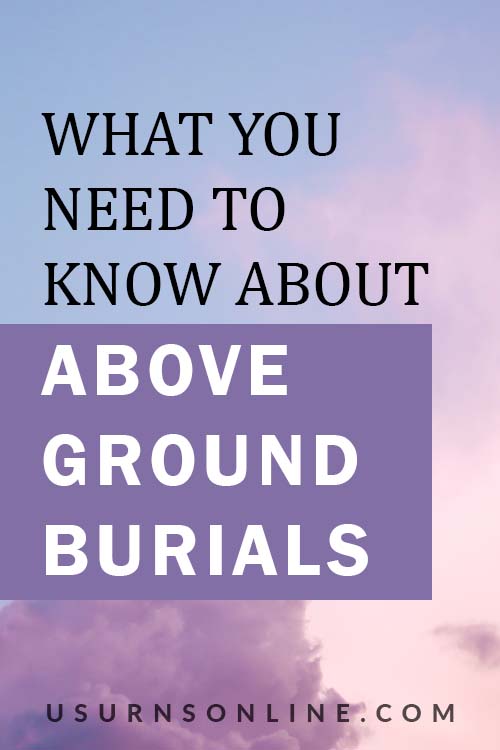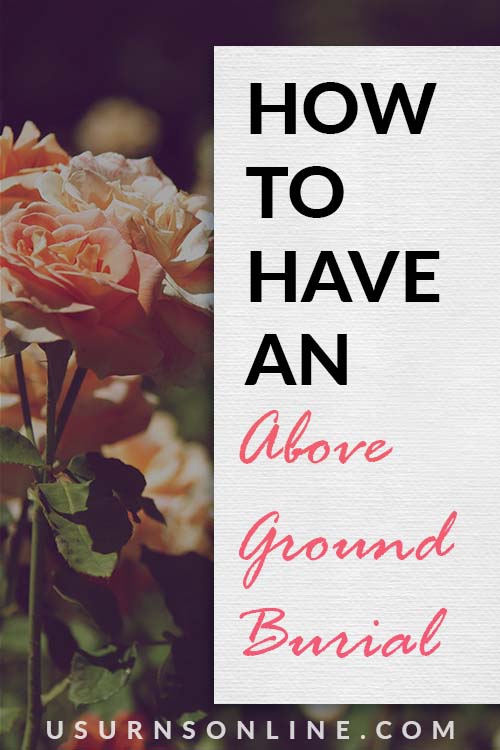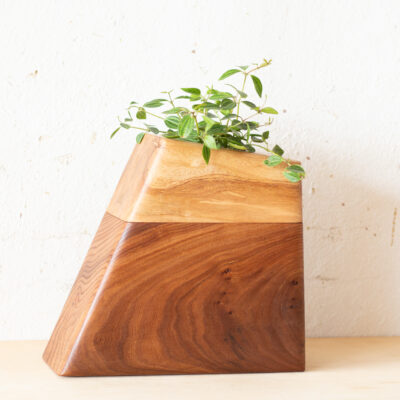We all know a little something about ground burial. But what about above ground burial?
The fate of all people, of every culture, lies six feet below the ground. No matter who you are, no matter who you know, one day you will die. You loved ones will tasked with what happens to your body.
When that time comes, if you’ve planned your funeral, you will have chosen a burial option. Otherwise the decision will be left to those who survive you and know you well enough to choose what will best honor your legacy.
Nowadays, most people choose cremation, followed closely by a traditional casket burial. But what if you want something a little different, something a little more?
There are many ways to be honorably buried. There are many methods of preservation which cultures of the past created so that the cold, unfeeling Earth would not have the final claim over their loved ones.
These options are still available. Let’s take a look at your above ground burial choices.
Above Ground Burial Options
The above ground options for burial are some of the more classical and decadent methods that have been practiced in the past.
Each of these practices have rich histories with deep significance across the lineages that popularized them. For those who want a death to be commemorated with firm, certain visibility, here is what you need to know.
Crypt in Mausoleum
The word mausoleum as we use it today was derived from the story of the first one ever built, back in 353 BC by Queen Artemisia of Caria. She wanted a fitting place to commemorate the remains of her husband, King Mausolus, and her brother. Thus, the monument was named after him, and we’ve used the name ever since.
All right, now let’s define it: A mausoleum is a building for housing the remains of the dead. The purpose of a mausoleum is to store the remains of the dead in such a way that it gives access to public or private entry for mourners to gather.
Urns Made in the USA
A crypt, meanwhile, is a more generic term. Crypts are stone or concrete holdings for remains, where the body is stored and inaccessible. This is the specific location where a coffin is placed, or the remains are laid bare to be interred not in dirt but in something far more solid and impermeable.
The crypt is then built into the mausoleum, as part of the structure, either in a wall or in a section of the flooring. They were usually underneath chapels and churches, but more modern crypts can hold above ground like vaults.
Public mausoleums offer this sort of arrangement for the deceased. Their remains are held with the remains of others in a shared environment where families can freely come to mourn or remember the dead under the same shelter. They are weatherproof and often tied to a religious body.
The iconic Taj Mahal of India is, in fact, the world’s most famous mausoleum. It was built for much of the same reason as the first one, to honor a beloved who passed away in a home as grand as a manor for anyone living.
Private Mausoleum
Public mausoleums come with public crowds. Burying a loved one in a gathering place like a cemetary or graveyard will have the same consequence that they will be exposed to the footfalls of strangers who are on their way to mourn another.
If the person was especially important, you could sprint to build a private mausoleum for just them, or for their spouse and family to join them when their times come. Having a private mausoleum creates a structure, a monument that stands out among the rest of the surroundings, dedicated wholly to one family or one individual.
Building a private mausoleum starts with acquiring the land to do so. Many cemeteries will work with you to create your own private, enclosed area on the cemetery grounds.
You can get even more personal with the location. Burial rights and laws dictate what kind of land can or can’t be used, but generally any private property will permit the construction of a long standing structure as long as it meets local protocols.
Mausoleums are made of hard material like stone or concrete to be as weatherproof as possible, but it can be built to any specification. Just know that the one who is stored in it will be there far longer than anyone who would be maintaining it.
Not to mention, building on private land is an intimate gesture, but that land might not belong to the same family who mourns that individual forever. Death lasts for eternity. Land rights, not so much.
Burial Wall
Another option for an outdoor, above-ground burial space is the burial wall. This is a wall with holes or slots (aka crypts) fitted to accommodate the remains of the dead in coffins or caskets. The deceased is lifted, casket and all, into the proper slot and assigned a placement just like any graveyard is given a lot.
The individual’s remains are honored in a unique way that isn’t in the ground. Plus, they aren’t alone. Burial walls can host dozens of deceased, in rows and columns, enough to cover – well, an entire wall.
Burial walls can also be built for much smaller, personal purposes as a sort of mini-mausoleum. They’re usually made of less extreme material, and the goal is for easy storage rather than ornate, monumental structures.
Building a wall outright will be much more costly, but buying the space in an already established burial wall is one of the least expensive means of storing the deceased in a humane, honorable way above ground.
Sarcophagus
Ancient Egyptian culture was steeped in beliefs about life after death. Their belief was so strong that the most powerful members of their society, the pharaohs, underwent mummification and entombment in vast structures we know as pyramids.
These were the most prodigious, epic mausoleums built, some taking years which started when the pharaoh was still alive and well, but their dedication to honoring their own death was an extreme point of honor and prestige. And these pharaohs were buried in the most ornate, significant crypts possible: the sarcophagus.
The word comes from Greek, meaning “flesh-eating stone” based both on the myths of the ancient burial rites of their Mediterranean neighbors as well as the properties of limestone, which was often used and which tended to cause more rapid decomposition.
A sarcophagus is a stone coffin, ornately decorated and stored in a manner to be visited and easily seen. They’ve been used in many cultures and have become modernized across the world as grave markers. Bodies can be buried on their burial plots in these stone coffins where they are protected from the elements and are given intricate stonework reliefs or statuettes to commemorate the one interred within.
A sarcophagus is like a miniature mausoleum, fit for only one, decorated for everyone to see, and designed to endure.
And perhaps – a few thousand years from now – it might be opened so our descendants can learn all about the life that person inside led.
Columbarium for Cremated Remains
Cremation has been around in one form or another since ancient times. First, in funeral pyres across the world from Aztec to ancient Phoenician, and now in modern times by mechanical cremation.
For those who cannot afford the land for burial plots, or for those whose attachment does not end at the body, cremation offers a humane manner to store a loved one’s remains in a more portable form.
Cremated remains are popularly kept in the family home in an urn, somewhere safe and visible without being toppled down. But accidents can happen. Urns are far easier to store than whole caskets and coffins, however, and they have their own kind of mausoleum for public viewing.
A columbarium is like a burial wall for urns, filled with niches where a loved one’s remains can be safely stored out of the elements and away from prying hands. Columbariums can be built, but most cemeteries already have space available in existing structures.
The Arlington National Cemetery in Virginia is one of the nation’s largest, with wall after wall of marble plaques to denote those who are resting within.
Above Ground Burial Cost
It’s never a good time to talk about the cost of death and burial, but it’s one of the many things that has to be dealt with as you make the final arrangements.
If you want to give your loved ones the best send off in the most fitting setting they deserve you will need to pay an appropriate price depending on the method you choose.
The costs for above ground burial will vary widely based on the state you live in, whether you’re in a big city or out in the country, the particular cemetery and plot within the cemetery you choose, and so on.
With that in mind, here are some approximate costs to give you the general idea of what to expect.
| Type | Cost |
| Crypt in Mausoleum | $7,000+ |
| Private Mausoleum | $50,000 – $125,000 |
| Burial Wall | $2,000 – $10,000 |
| Sarcophagus | $~67,000 |
| Columbarium Niche | $500 – $2,500 |
10 Things You Should Know About Above Ground Burial
1. Above ground burial is expensive.
As you can see from the numbers above, a private mausoleum or an above-ground sarcophagus can easily set you back by $50,000. Even a standard crypt in an already-established mausoleum wall will add many thousands to your final bill.
But it’s not always about the cost. Sometimes, the final result is worth it. If you want a truly remarkable monument to your beloved, above-ground burial is the top of the line.
2. Above ground burial is truly monumental.
Above ground burial involves so much more than a simple headstone or grave marker. You’re building the burial site around your loved one. Such a memorialization will endure the ravages of time.
The structure will be made of stone, iron, and concrete. The walls will be thick and the edifice will rise up above the earth. You can further accent it with statues, plaques, carvings, and other decorations.
This is a monumental task! It conveys a sense of how much the individual meant to you and to all who knew them.
Related: 100 Quotes on Tombstones That Won’t Be Forgotten
3. Above ground burial typically means a mausoleum.
Whether public or private, family or individual, the typical above-ground burial option is a mausoleum. That will be the topic of initial discussion you have with the funeral director and cemetery sexton.
From there, you can explore customization and other options.
4. Mausoleums are becoming more common in urban areas.
Because cemetery land space is limited. The only way for many city areas with dense population to extend their burial options is with above-ground burials. Expect to see more mausoleums and burial walls in urban areas.
5. Cremated remains can be buried above ground, too.
A mausoleum for cremated remains is called a columbarium. Cremated remains and the urn take up much less space than the traditional casket. This means that columbarium niches are much more affordable and easily built.
6. Each method has a rich cultural history tied to it.
Different cultures and regions have unique and interesting funeral traditions. The crypt, the mausoleum, the sarcophagus, cremation, traditional burial – all of these burial methods are rooted in humanity’s many varied heritages.
The one thing that draws us together is that we must all, one day, face death. What will you do about it? What will be your legacy? How will you be remembered? Here are 30 helpful questions to help you think about it deeply and well.
7. Active mummification is somewhat frowned upon in the modern day.
There is a sense in which above ground burial is an attempt to preserve the remains of the departed. That is why the ancient Egyptian practices of mummification and above-ground tombs are so closely tied together.
We don’t mummify bodies anymore – at least, not in the same way. Modern funeral directors use embalming, which is a process that uses chemicals to temporarily slow the natural bodily decay. This makes the individual more presentable and “lifelike” for public viewing, for instance at an open-casket funeral.
Above ground burial, embalming, and even mummification won’t eternally preserve your loved one. The best ways to memorialize them and honor their legacy are to remember and reflect on the stories of their life, and to create a special monument in their honor.
8. Your relatives and friends will still get to “see” you.
There’s something special about visiting a cemetery. You can spend time where your loved one has been laid to rest. It’s a beautiful opportunity to reflect on life out in the beauty of nature. It’s usually quiet and peaceful, and there is plenty of space to think, pray, journal, and even talk out loud.
A great monument such as a mausoleum will be all the more of a draw. It’s one thing to see a simple headstone; it’s another thing entirely to walk into a building dedicated specifically to your loved one.
9. Private cemeteries have higher security than public graveyards to prevent grave robbers.
Thankfully, grave robbing is much more rare than in times past. Still, grave sites can be defaced, and the better security afforded by private cemeteries prevents this sort of thing from happening.
10. Crypts will be there for when a loved one is ready to join you in eternal rest.
One last draw of the private family mausoleum is that they reser space reserved for those who remain behind. You’ll know that one day, you’ll be side by side again – together, forever.
Read Next: Traditional & Non-Traditional Burial Guide
Pin It




